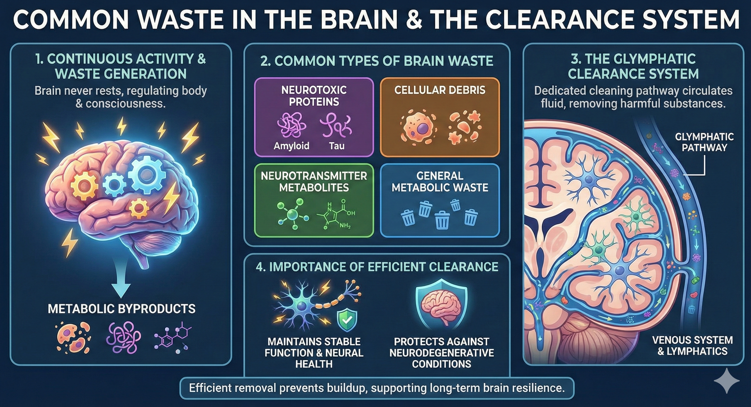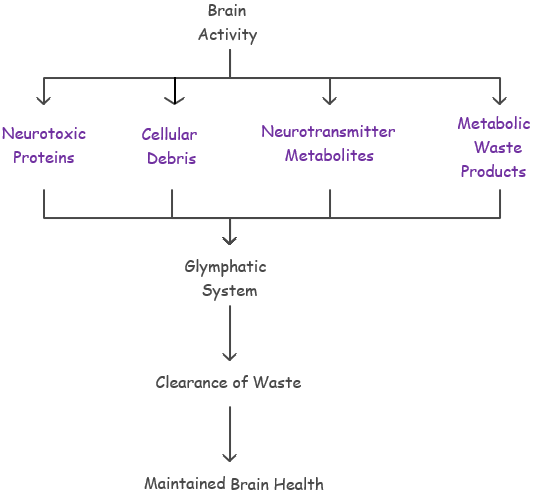|
|
||
|
The brain, a complex and energy-intensive organ, constantly generates waste products as a byproduct of its numerous activities. These waste products include various metabolic byproducts, cellular debris from dead or dying neurons, and potentially harmful proteins like amyloid-beta and tau, which are implicated in neurodegenerative diseases. The accumulation of these waste products can disrupt neural communication, impair cognitive function, and ultimately contribute to brain damage. To maintain optimal health and function, the brain relies on intricate waste clearance mechanisms to efficiently eliminate these waste products. These mechanisms operate at both the cellular and systemic levels, involving various specialized cells, fluid dynamics, and intricate pathways. Failure or disruption of these waste removal processes can lead to a buildup of toxic substances within the brain, contributing to the development and progression of neurological disorders. Understanding the brain's waste removal mechanisms is crucial for unraveling the underlying causes of neurodegenerative diseases and developing effective therapeutic interventions. Research in this area has highlighted the significance of factors such as sleep, physical activity, and aging in influencing the efficiency of waste clearance processes. By exploring the intricate workings of the brain's waste removal system, scientists hope to uncover novel strategies for promoting brain health and combating neurological diseases.
What are common waste in brain ?The brain produces several types of metabolic waste. This waste is a natural byproduct of the brainís intense and continuous activity. The brain never fully rests. It processes information. It regulates the entire body. It keeps consciousness running. All of this requires energy. And every energy-consuming process produces waste. As a result, various substances build up inside the brain. Some of these substances can be harmful if they accumulate. Some are neurotoxic proteins. Some are small fragments of broken or old cellular material. Some are metabolites produced when neurotransmitters are used and broken down. Others come from basic metabolic reactions inside neurons and glial cells. Each type adds to the overall cleanup requirement inside the brain.
The brain must remove these materials efficiently. If not, the waste would interfere with neural activity. It could slow signal transmission, disrupt homeostasis, or even push the system toward disease. For this reason, the brain uses a dedicated clearance network. This network is called the glymphatic system. It acts as the brainís cleaning pathway. It circulates fluid, washes out waste, and moves harmful substances toward areas where they can be removed. This waste-clearance process is critical. It helps the brain maintain stable function. It supports long-term health of neurons. It also protects the brain from neurodegenerative conditions linked to waste buildup. Understanding these waste types and how they are cleared helps you see how the brain sustains its efficiency and preserves its overall resilience.
Neurotoxic ProteinsNeurotoxic proteins, such as amyloid-beta, are critical factors in the pathogenesis of various neurodegenerative diseases, most notably Alzheimerís disease. These proteins are produced as natural byproducts of cellular processes, but their accumulation and aggregation can disrupt normal brain function, leading to cellular damage and cognitive decline. Amyloid-beta, for example, forms plaques that interfere with neuronal communication and trigger inflammatory responses, contributing to the progressive degeneration of neural tissue. The brain's waste removal systems, including the glymphatic system, are vital for clearing these harmful proteins to maintain neural health. Research into the mechanisms of neurotoxic protein clearance is essential for developing therapeutic strategies to combat neurodegenerative diseases and enhance brain longevity.
Cellular DebrisCellular debris in the brain encompasses a variety of waste products generated from the natural lifecycle and metabolism of neural cells. This debris includes the remnants of dead cells, damaged cellular components, and other byproducts that arise from the intense and intricate activities of neurons and glial cells. Effective clearance of cellular debris is essential for maintaining brain homeostasis and preventing inflammation and neurodegenerative conditions. The brain's waste removal mechanisms, particularly the glymphatic system, play a crucial role in managing this cellular detritus, ensuring that the neural environment remains conducive to optimal cognitive and physiological function. Understanding the dynamics of cellular debris clearance offers valuable insights into the prevention and treatment of brain-related disorders.
Neurotransmitter MetabolitesNeurotransmitter metabolites are byproducts of the complex signaling processes that enable communication between neurons in the brain. Neurotransmitters such as glutamate and GABA play critical roles in excitatory and inhibitory signaling, respectively. However, once they have fulfilled their signaling roles, they are broken down into various metabolites that must be efficiently cleared to maintain neural homeostasis and prevent excitotoxicity or inhibitory imbalances. The accumulation of these metabolites can disrupt normal brain function and contribute to neurological disorders. Effective clearance mechanisms, including enzymatic degradation and the glymphatic system, are essential for the proper regulation of neurotransmitter levels and the maintenance of a healthy neural environment. Understanding the pathways involved in the metabolism and clearance of neurotransmitter byproducts provides valuable insights into maintaining cognitive function and preventing neurodegenerative diseases.
Metabolic Waste ProductsMetabolic waste products in the brain are inevitable byproducts of the intense and continuous activity of neural cells. These wastes include lactate from anaerobic glycolysis and carbon dioxide from aerobic metabolism. Efficient removal of these metabolic byproducts is crucial to prevent toxicity and maintain the delicate biochemical balance required for optimal brain function. The brain employs sophisticated clearance mechanisms, such as the glymphatic system, to transport these wastes out of neural tissue and into the bloodstream for elimination. Understanding the processes involved in the clearance of metabolic waste is essential for insights into brain health, the prevention of metabolic disorders, and the development of therapeutic strategies to support cognitive function and overall neurological well-being.
Brain's Waste Clearance System : Glymphatic SystemThe glymphatic system is a recently discovered and crucial waste clearance mechanism in the brain, analogous to the lymphatic system in the rest of the body. This system operates primarily during sleep, using cerebrospinal fluid (CSF) to flush out metabolic waste products, toxins, and other debris from the brain's interstitial spaces. The glymphatic system involves a network of channels formed by glial cells, particularly astrocytes, which facilitate the efficient removal of harmful substances such as amyloid-beta and tau proteins. By maintaining a clean neural environment, the glymphatic system plays a vital role in preventing neurodegenerative diseases and supporting cognitive function. Understanding and enhancing the glymphatic system's function holds significant potential for developing treatments for various neurological conditions and promoting overall brain health.
Cerebrospinal Fluid (CSF)Cerebrospinal fluid (CSF) is a clear, colorless fluid produced by the choroid plexus, a network of cells within the brainís ventricles. It serves as the primary medium for waste removal in the glymphatic system. CSF is produced in the choroid plexus within the ventricles of the brain. It circulates through the ventricular system and the subarachnoid space, eventually entering the perivascular spaces.
Perivascular SpaceThe perivascular spaces are narrow channels surrounding the brainís blood vessels (arteries and veins), serving as the primary pathways for fluid movement in the glymphatic system. It involves a network of channels that surround the blood vessels in the brain. It critical for the movement of cerebrospinal fluid (CSF).
AstrocytesAstrocytes are star-shaped glial cells that are integral to the glymphatic system. Their projections, known as endfeet, encase the brainís blood vessels, forming part of the perivascular space. They are crucial in regulating the flow of CSF and interstitial fluid (ISF).
Waste Removal ProcessThe waste removal process in the brain is a fundamental aspect of maintaining neural health and preventing the onset of neurodegenerative diseases. This intricate system primarily involves the glymphatic system, which utilizes cerebrospinal fluid (CSF) to clear metabolic waste, toxins, and cellular debris from the brain's interstitial spaces. Active mainly during sleep, this process relies on the coordinated function of astrocytes and the perivascular spaces around blood vessels to ensure efficient waste clearance. By removing harmful substances such as amyloid-beta and tau proteins, the waste removal process helps preserve cognitive function and overall brain health. Understanding the mechanisms of this system is crucial for developing therapeutic strategies aimed at enhancing brain function and preventing neurological disorders. This intricate process of CSF influx, ISF movement, and CSF efflux constitutes the glymphatic system, the brain's waste clearance system. Efficient glymphatic clearance is crucial for maintaining brain health and preventing the accumulation of toxic substances that can contribute to neurodegenerative diseases. Disruptions in this system have been implicated in various neurological disorders, underscoring the importance of understanding and optimizing glymphatic function.
CSF InfluxThe influx of cerebrospinal fluid (CSF) into the brain is a dynamic process that is essential for waste removal. CSF, produced within the brain's ventricles, enters the brain parenchyma through perivascular spaces that surround arteries. This influx is driven by several factors:
Interstitial Fluid Movement:Once CSF enters the brain, it mixes with interstitial fluid (ISF), the fluid surrounding brain cells. ISF acts as a medium for the exchange of nutrients and waste products between cells and the bloodstream. The CSF-ISF mixture flows through the brain tissue, collecting metabolic waste products, including proteins, cellular debris, and neurotoxic substances like amyloid-beta. This continuous flow is essential for maintaining a healthy brain environment. CSF Efflux:The CSF-ISF mixture, now laden with waste products, moves towards the perivascular spaces surrounding veins. Unlike the arterial influx, the efflux of CSF along veins is less dependent on pulsations and more reliant on bulk flow. The waste-laden fluid then exits the brain through lymphatic vessels located in the meninges, the protective membranes surrounding the brain. From there, it enters the systemic circulation, where waste products can be processed and eliminated by the body's organs, such as the liver and kidneys. Why waste removal is important ?Waste removal in the brain is not merely a housekeeping task, but a vital physiological process that underpins the brain's optimal functioning and long-term health. The brain, with its intricate network of neurons and glial cells, constantly generates byproducts of its metabolic activity, including cellular debris, neurotransmitters, and potentially toxic proteins. If these waste products are not efficiently cleared, they can accumulate and disrupt neural communication, trigger inflammation, and contribute to the development of various neurological disorders. Effective waste removal mechanisms in the brain act as a safeguard against these detrimental effects. By preventing the buildup of harmful substances, these mechanisms ensure a healthy environment for neurons to function optimally. This includes maintaining a delicate balance of ions and neurotransmitters, essential for proper synaptic transmission and neural signaling. Moreover, waste removal processes protect the brain from damage caused by oxidative stress and inflammation, which are implicated in neurodegenerative diseases such as Alzheimer's and Parkinson's. In conclusion, waste removal in the brain is a fundamental process that ensures the optimal functioning and longevity of this complex organ. By preventing the accumulation of harmful substances, maintaining homeostasis, and protecting against damage, waste removal mechanisms play a crucial role in maintaining brain health and preventing a wide range of neurological diseases. Understanding and optimizing these mechanisms offer promising avenues for developing therapeutic interventions for neurodegenerative disorders and promoting overall brain health.
Waste removal in the brain is essential for several key reasons:
How sleep affects waste removal process ?Sleep plays a crucial role in the brain's waste removal process, particularly through its influence on the glymphatic system, the brain's waste clearance system. Adequate sleep promotes efficient glymphatic flow, enhances the clearance of neurotoxic substances, regulates glymphatic-related genes, and maintains the circadian rhythm necessary for optimal waste removal. Conversely, sleep deprivation or disruption can impair these processes, leading to the accumulation of harmful substances and increasing the risk of neurodegenerative diseases.
There are Several key mechanisms link sleep and waste removal:
Reference
YouTube
|
||






